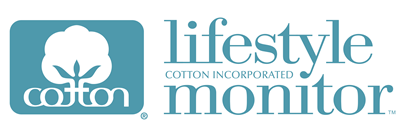
BEYOND COVID
DEMAND & PRICES
COTTON INCORPORATED’S
|
SUPPLY CHAIN INSIGHTS
U.S. GDP is estimated to have
surpassed its pre-COVID peak
in the second quarter.
1
Online sales have been a big part of that, but brick and mortar
sales are up 15% vs 2019, which is an indication of wide-
spread strength in consumer demand for clothing.
1,3
Year-over-year comparison distorted by COVID-driven shutdown orders last year.
With COVID, there was record contractions and record growth.
This makes year-over-comparison against 2020 challenging.
What has been feeding growth in apparel spending?
HIGHER SAVINGS
RISING WAGES
STIMULUS
SURGINGECONOMY
2019
2020
2021
2022
+2.2%
-3.5%
+7.0%
+4.9%
Sources: US Bureau of Economic Analysis,
International Monetary Fund (IMF)
ESTIMATES FOR U.S. GDP GROWTH
The U.S. has not only recovered
but is expected to enjoy strong
growth into the future.
1,2
The growth rates expected in
both 2021 and 2022 are more
than double the rate of growth
in 2019.
1,2
2X
Relative to 2019, apparel spending has been up 25% in recent
months. Normal annual growth is near 3%, so there has been
more growth than could have been expected without COVID.
INFO: MARKETINFORMA[email protected] LIFESTYLEMONITOR.COTTONINC.COM
Throughout the supply chain there are a swirl of influences. While fiber and yarn prices have responded to
stronger demand post-COVID, import costs and retail prices are still recovering from COVID-driven lows.
3-5, 7
2021 apparel imports have been the strongest since
2010, and home imports are set to post a new record.
Even though imports have been increasing, retailer
inventories have been falling. After reaching
record highs during the pandemic, the clothing store
inventory/sales ratio has fallen to a record low.
STRONGER
FIBER
DEMAND
Despite high volumes of imports,
a concern for many retailers is
whether or not they might have
enough inventory to keep up with
consumer demand as we approach
the important holiday sales period.
3
=
U.S. economic growth is forecast to continue to be strong
and consumers have a healthy appetite for apparel.
SUPPLYCHAINPRICES
Increases in shipping
costs and higher
fiber and yarn prices
can be expected to
lift prices for imports
and at retail.
Further into the future,
price increases in raw
materials and shipping
may ease while the
economy is expected
to continue to grow at
strong rates.
FIBER PRICES
34%
YARN PRICES
30%
IMPORT APPAREL
PRICES
8%
FUTURE
FORECAST
STRONGER
CONSUMER
DEMAND
RETAIL APPAREL
PRICES
1%
0
2
4
6
8
10
12
14
16
18
Apparel
Home
raw fiber equivalence, mil. bales
Sources: US Census, USDA ERS, Cotton Incorporated calculations
+1.5 mil. bales
vs pre-COVID level
+0.5 mil. bales
vs pre-COVID level
COTTON IN U.S. APPAREL & HOME IMPORTS
DATA DESCRIBE THE PERCENTAGE CHANGE FOR THE LATEST AVAILABLE MONTHLY FIGURES RELATIVE TO JANUARY 2020.
Sources:
1
US Bureau of Economic Analysis,
2
International Monetary Fund (IMF),
3
US Census,
4
USDA ERS,
5
Cotton Incorporated calculations,
6
Reuters,
7
Cotlook, and
8
US BLS.
©2021 Cotton Incorporated.
STRONGER
IMPORT
DEMAND
=









